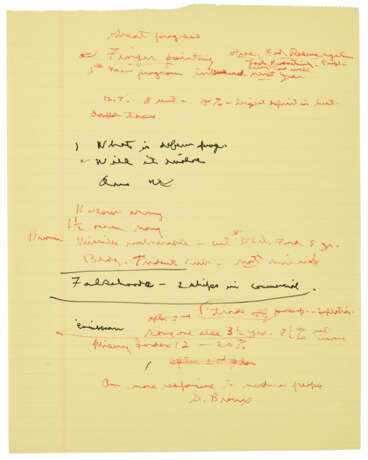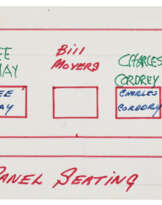ID 1033019
Lot 358 | Preparation notes for his debate against Jimmy Carter
Valeur estimée
$ 30 000 – 50 000
Three pages, 275 x 217mm on yellow pad stationery (slightly irregular upper margins, small dogear to lower left corner). One page, 279 x 215mm on "National Headquarters Reagan-Bush Committee Memorandum" stationery (small toned spot at lower right corner, small dogear at lower left corner).
"Turn to the Carter Record!!!"—Ronald Reagan's preparation notes for his historic 1980 debate against Jimmy Carter—signed and inscribed and kept by his debate coach. An important piece of presidential history: a series of notes taken by Ronald Reagan as he prepared for his debate against Jimmy Carter in the runup to the 1980 presidential election. The League of Women Voters had scheduled four debates for the fall election season: three for the presidential candidates and one for the vice presidential hopefuls. The first had been held on 21 September and had pitted Regan against John Anderson, the Republican-turned-independent candidate for the Presidency. President Carter had refused to participate if Anderson was included, while Reagan had insisted that Anderson be present. The ensuing impasse saw the cancellation of a second presidential and the vice presidential debate. However, two weeks prior to the general election, The League of Women Voters dropped their instance that Anderson be present. The Carter-Reagan debate was scheduled for 28 October in Cleveland, Ohio.
To help prepare for his encounter with Carter, Reagan retained Myles Martel, a seasoned debate coach. Martel, together Reagan's debate task force, led by James Baker and assisted by Bill Caruthers, Frank Ursomarso, David Gergen and Frank Hodsoll. They were assisted by Reagan's closest aid, Ed Meese, campaign manager, William Casey and pollster and chief strategist, Richard Wirthlin. On 25 October they gathered at Wexford, the former country retreat of Jack and Jackie Kennedy in rural Virginia, where the Reagans had been residing since September. To set the stage, they first played video excerpts of Carter's 1976 debate with Gerald Ford. During this session, Reagan took the present notes. According to Martel, after that briefing, he and James Baker went over a series of strategies for Reagan to employ in the debate. First and foremost was to "keep the debate focused as much as possible on Carter's record." (Martel, "Debate Preparations in the Reagan Camp: An Insider's View," Speaker and Gavel, 18:2 (1981), p. 42) At the top of one of the pages, Reagan writes, boldly: "Turn to Carter Record!!!" The notes continued over several pages, covering a wide range of topics, from arms control to inflation to tax policy and urban renewal preparing for what might come from his opponent.
On one page, headed "Great progress," Reagan writes: "Finger pointing." Reagan would employ this during the debate to accuse Carter of not taking responsibility for inflation. It came in response to a question by Harry Ellis, of the Christian Science Monitor, on the causes of inflation, to which Reagan responded, in part, that Carter, had "blamed the people for inflation, OPEC, he has blamed the Federal Reserve system, he has blamed the lack of productivity of the American people, he has then accused the people of living too well and that we must share in scarcity, we must sacrifice and get used to doing with less. We don’t have inflation because the people are living too well. We have inflation because the Government is living too well." Further down the same page, Regan writes "misery index," which proved relevant when Barbara Walters asked why voters should not vote for his opponent. To this Regan responded, "…when he was a candidate in 1976, President Carter invented a thing he called the misery index. He added the rate of unemployment and the rate of inflation, and it came, at that time, to 12.5% under President Ford. He said that no man with that size misery index has a right to seek reelection to the Presidency. Today, by his own decision, the misery index is in excess of 20%, and I think this must suggest something…." And just below that line, Reagan writes, "Am more responsive to needs of people. S[outh] Bronx." He would deftly employ this anecdote against his oppoinent in response to William Hillard of the Portland Oregonian: "I stood in the South Bronx on the exact spot that President Carter stood on in 1977. You have to see it to believe it. It looks like a bombed-out city – great, gaunt skeletons of buildings. Windows smashed out, painted on one of them 'Unkept promises;' on another, 'Despair.' And this was the spot at which President Carter had promised that he was going to bring in a vast program to rebuild this department."
Foreign policy and arms control also figured prominently in the late October encounter between the two candidates. The final line on the page featuring his doodles at the top, reads "Withdrew it in 12 hrs. (Salt II)." This was in reference to, in Regan's words that evening, "The SALT II treaty [which] was the result of negotiations that Mr. Carter’s team entered into after he had asked the Soviet Union for a discussion of actual reduction of nuclear strategic weapons. And his emissary, I think, came home in 12 hours having heard a very definite nyet. … The Soviet Union sat at the table knowing that we had gone forward with unilateral concessions without any reciprocation from them whatsoever. Now, I have not blocked the SALT II treaty, as Mr. Carter and Mr. Mondale suggest I have. It has been blocked by a Senate in which there is a Democratic majority. Indeed, the Senate Armed Services Committee voted 10 to 0, with seven abstentions, against the SALT II treaty, and declared that it was not in the national security interests of the United States."
Over the next several days, Reagan continued his preparation, participating in mock debates with Rep. David Stockman playing Carter in a garage that had been converted to resemble a television set. Martel even played one of the panelists during those sessions. Reagan's performance in that debate—which drew over 80 million viewers—proved decisive—especially the now famous deflection of Carter's accusation that the former California governor was too extreme to hold office. His easygoing and folksy response, "There you go again" effectively neutralized Carter's attacks. The former California governor proved the picture of confidence and his performance that night did much to propel him to the White House during the general election the following week.
Martel, Reagan's debate coach, had hoped to obtain a souvenir as a gift for his son, and thought he might get his hands on some jellybeans, Reagan's favorite snack. But by the end of the day, the jellybean jar was empty. Thinking quickly, Martel found Reagan's notes and asked him to inscribe it to his son. Reagan graciously agreed and write: "Hi David As you can see fast writing isn't very good. Best Regards Ronald Reagan" Provenance: Myles Martel – gift to the consignor.
| Artiste: | Ronald Reagan (1911 - 2004) |
|---|---|
| Lieu d'origine: | Etats-Unis |
| Catégorie maison de vente aux enchères: | Lettres, documents et manuscrits |
| Artiste: | Ronald Reagan (1911 - 2004) |
|---|---|
| Lieu d'origine: | Etats-Unis |
| Catégorie maison de vente aux enchères: | Lettres, documents et manuscrits |
| Adresse de l'enchère |
CHRISTIE'S 20 Rockefeller Plaza 10020 New York Etats-Unis | ||||||||||||||
|---|---|---|---|---|---|---|---|---|---|---|---|---|---|---|---|
| Aperçu |
| ||||||||||||||
| Téléphone | +1 212 636 2000 | ||||||||||||||
| Fax | +1 212 636 4930 | ||||||||||||||
| Conditions d'utilisation | Conditions d'utilisation | ||||||||||||||
| transport |
Service postal Service de messagerie ramassage par vous-même | ||||||||||||||
| Modes de paiement |
Virement bancaire | ||||||||||||||
| Heures d'ouverture | Heures d'ouverture
|







